Holmes Institute HI6006 Competitive Strategy Tutorial Questions
VerifiedAdded on 2023/01/11
|8
|2004
|55
Homework Assignment
AI Summary
This assignment provides answers to tutorial questions for the HI6006 Competitive Strategy unit, covering topics from weeks 2-6. It begins with an introduction to the importance of external factors in business and discusses various strategic approaches. The assignment includes a PESTLE analysis framework, examining political, economic, social, technological, legal, and environmental factors. It then analyzes Zara's tangible and intangible resources, followed by a comparison of Apple and Samsung's business strategies. The assignment also delves into Tesco's application of Porter's Five Forces model and concludes with the reasons behind LVMH's diversification strategy. The document is well-structured, providing concise explanations and real-world examples to illustrate key concepts in competitive strategy.
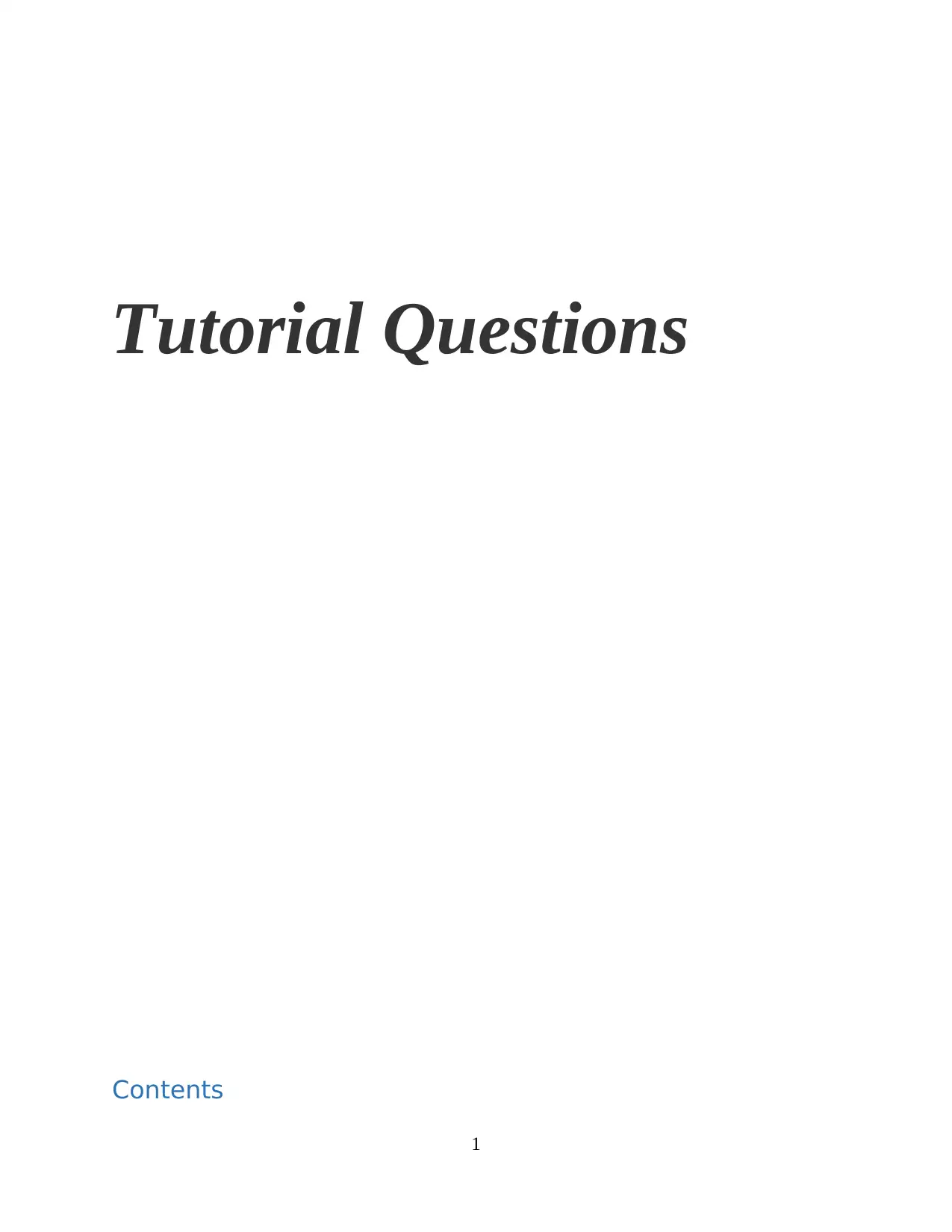
Tutorial Questions
Contents
1
Contents
1
Paraphrase This Document
Need a fresh take? Get an instant paraphrase of this document with our AI Paraphraser
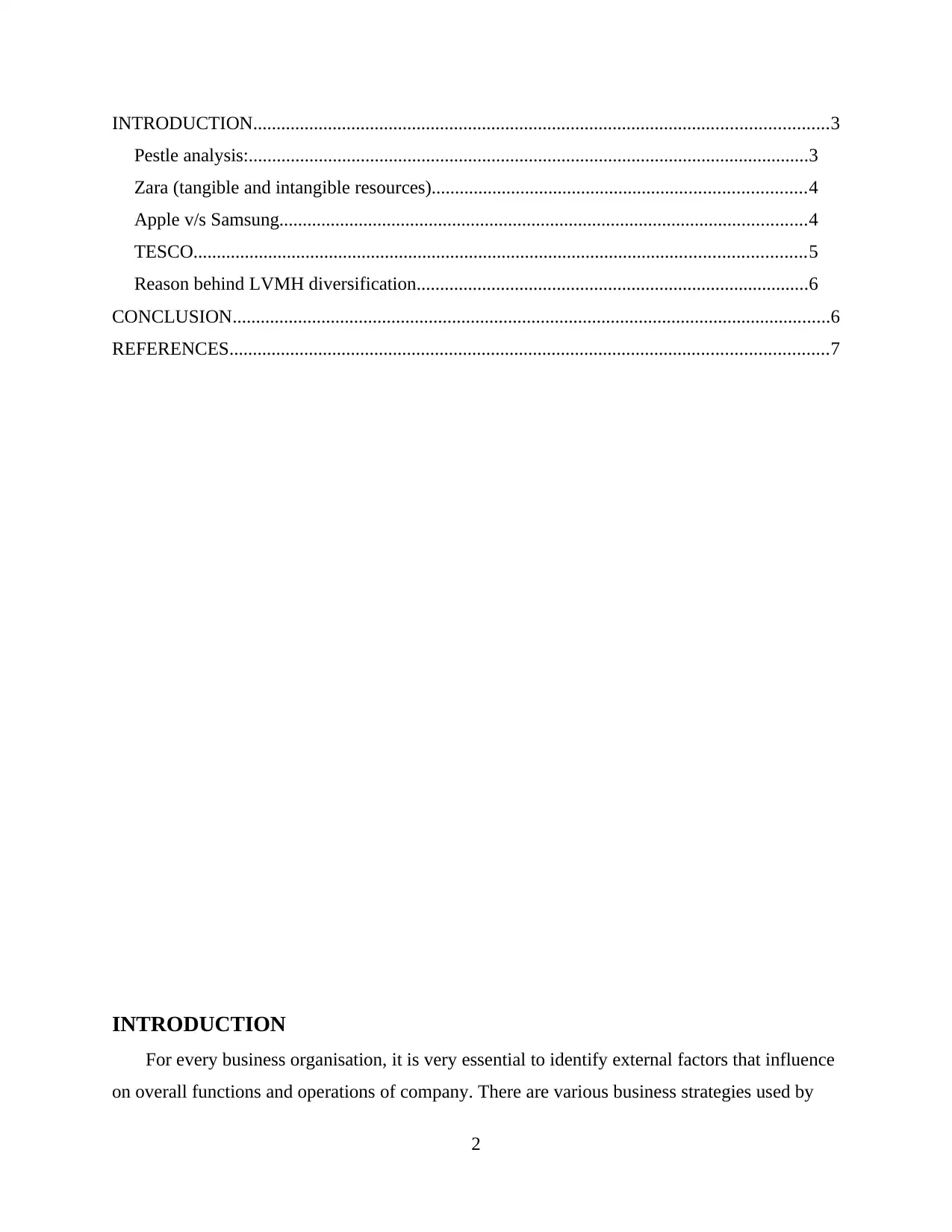
INTRODUCTION...........................................................................................................................3
Pestle analysis:........................................................................................................................3
Zara (tangible and intangible resources)................................................................................4
Apple v/s Samsung.................................................................................................................4
TESCO...................................................................................................................................5
Reason behind LVMH diversification....................................................................................6
CONCLUSION................................................................................................................................6
REFERENCES................................................................................................................................7
INTRODUCTION
For every business organisation, it is very essential to identify external factors that influence
on overall functions and operations of company. There are various business strategies used by
2
Pestle analysis:........................................................................................................................3
Zara (tangible and intangible resources)................................................................................4
Apple v/s Samsung.................................................................................................................4
TESCO...................................................................................................................................5
Reason behind LVMH diversification....................................................................................6
CONCLUSION................................................................................................................................6
REFERENCES................................................................................................................................7
INTRODUCTION
For every business organisation, it is very essential to identify external factors that influence
on overall functions and operations of company. There are various business strategies used by
2
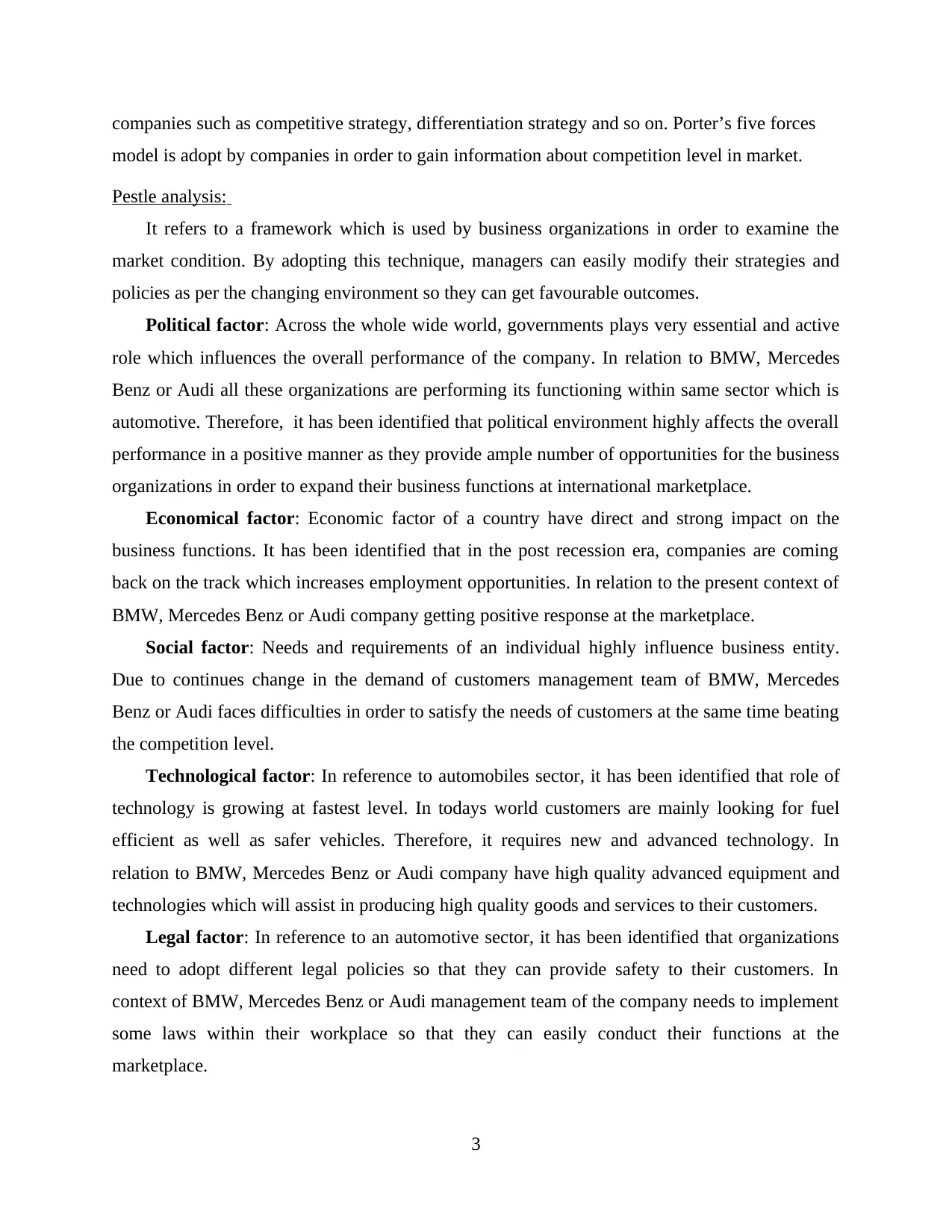
companies such as competitive strategy, differentiation strategy and so on. Porter’s five forces
model is adopt by companies in order to gain information about competition level in market.
Pestle analysis:
It refers to a framework which is used by business organizations in order to examine the
market condition. By adopting this technique, managers can easily modify their strategies and
policies as per the changing environment so they can get favourable outcomes.
Political factor: Across the whole wide world, governments plays very essential and active
role which influences the overall performance of the company. In relation to BMW, Mercedes
Benz or Audi all these organizations are performing its functioning within same sector which is
automotive. Therefore, it has been identified that political environment highly affects the overall
performance in a positive manner as they provide ample number of opportunities for the business
organizations in order to expand their business functions at international marketplace.
Economical factor: Economic factor of a country have direct and strong impact on the
business functions. It has been identified that in the post recession era, companies are coming
back on the track which increases employment opportunities. In relation to the present context of
BMW, Mercedes Benz or Audi company getting positive response at the marketplace.
Social factor: Needs and requirements of an individual highly influence business entity.
Due to continues change in the demand of customers management team of BMW, Mercedes
Benz or Audi faces difficulties in order to satisfy the needs of customers at the same time beating
the competition level.
Technological factor: In reference to automobiles sector, it has been identified that role of
technology is growing at fastest level. In todays world customers are mainly looking for fuel
efficient as well as safer vehicles. Therefore, it requires new and advanced technology. In
relation to BMW, Mercedes Benz or Audi company have high quality advanced equipment and
technologies which will assist in producing high quality goods and services to their customers.
Legal factor: In reference to an automotive sector, it has been identified that organizations
need to adopt different legal policies so that they can provide safety to their customers. In
context of BMW, Mercedes Benz or Audi management team of the company needs to implement
some laws within their workplace so that they can easily conduct their functions at the
marketplace.
3
model is adopt by companies in order to gain information about competition level in market.
Pestle analysis:
It refers to a framework which is used by business organizations in order to examine the
market condition. By adopting this technique, managers can easily modify their strategies and
policies as per the changing environment so they can get favourable outcomes.
Political factor: Across the whole wide world, governments plays very essential and active
role which influences the overall performance of the company. In relation to BMW, Mercedes
Benz or Audi all these organizations are performing its functioning within same sector which is
automotive. Therefore, it has been identified that political environment highly affects the overall
performance in a positive manner as they provide ample number of opportunities for the business
organizations in order to expand their business functions at international marketplace.
Economical factor: Economic factor of a country have direct and strong impact on the
business functions. It has been identified that in the post recession era, companies are coming
back on the track which increases employment opportunities. In relation to the present context of
BMW, Mercedes Benz or Audi company getting positive response at the marketplace.
Social factor: Needs and requirements of an individual highly influence business entity.
Due to continues change in the demand of customers management team of BMW, Mercedes
Benz or Audi faces difficulties in order to satisfy the needs of customers at the same time beating
the competition level.
Technological factor: In reference to automobiles sector, it has been identified that role of
technology is growing at fastest level. In todays world customers are mainly looking for fuel
efficient as well as safer vehicles. Therefore, it requires new and advanced technology. In
relation to BMW, Mercedes Benz or Audi company have high quality advanced equipment and
technologies which will assist in producing high quality goods and services to their customers.
Legal factor: In reference to an automotive sector, it has been identified that organizations
need to adopt different legal policies so that they can provide safety to their customers. In
context of BMW, Mercedes Benz or Audi management team of the company needs to implement
some laws within their workplace so that they can easily conduct their functions at the
marketplace.
3
⊘ This is a preview!⊘
Do you want full access?
Subscribe today to unlock all pages.

Trusted by 1+ million students worldwide
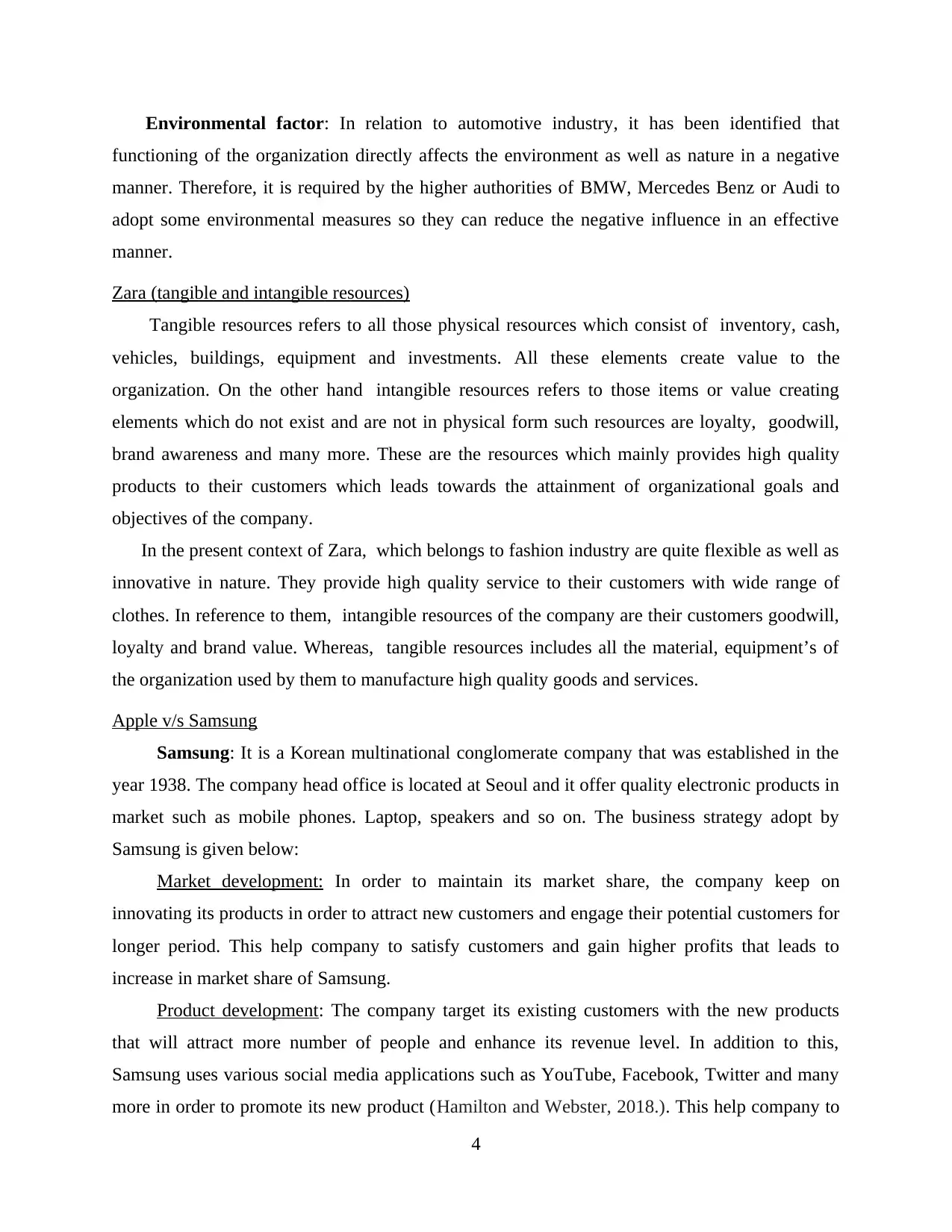
Environmental factor: In relation to automotive industry, it has been identified that
functioning of the organization directly affects the environment as well as nature in a negative
manner. Therefore, it is required by the higher authorities of BMW, Mercedes Benz or Audi to
adopt some environmental measures so they can reduce the negative influence in an effective
manner.
Zara (tangible and intangible resources)
Tangible resources refers to all those physical resources which consist of inventory, cash,
vehicles, buildings, equipment and investments. All these elements create value to the
organization. On the other hand intangible resources refers to those items or value creating
elements which do not exist and are not in physical form such resources are loyalty, goodwill,
brand awareness and many more. These are the resources which mainly provides high quality
products to their customers which leads towards the attainment of organizational goals and
objectives of the company.
In the present context of Zara, which belongs to fashion industry are quite flexible as well as
innovative in nature. They provide high quality service to their customers with wide range of
clothes. In reference to them, intangible resources of the company are their customers goodwill,
loyalty and brand value. Whereas, tangible resources includes all the material, equipment’s of
the organization used by them to manufacture high quality goods and services.
Apple v/s Samsung
Samsung: It is a Korean multinational conglomerate company that was established in the
year 1938. The company head office is located at Seoul and it offer quality electronic products in
market such as mobile phones. Laptop, speakers and so on. The business strategy adopt by
Samsung is given below:
Market development: In order to maintain its market share, the company keep on
innovating its products in order to attract new customers and engage their potential customers for
longer period. This help company to satisfy customers and gain higher profits that leads to
increase in market share of Samsung.
Product development: The company target its existing customers with the new products
that will attract more number of people and enhance its revenue level. In addition to this,
Samsung uses various social media applications such as YouTube, Facebook, Twitter and many
more in order to promote its new product (Hamilton and Webster, 2018.). This help company to
4
functioning of the organization directly affects the environment as well as nature in a negative
manner. Therefore, it is required by the higher authorities of BMW, Mercedes Benz or Audi to
adopt some environmental measures so they can reduce the negative influence in an effective
manner.
Zara (tangible and intangible resources)
Tangible resources refers to all those physical resources which consist of inventory, cash,
vehicles, buildings, equipment and investments. All these elements create value to the
organization. On the other hand intangible resources refers to those items or value creating
elements which do not exist and are not in physical form such resources are loyalty, goodwill,
brand awareness and many more. These are the resources which mainly provides high quality
products to their customers which leads towards the attainment of organizational goals and
objectives of the company.
In the present context of Zara, which belongs to fashion industry are quite flexible as well as
innovative in nature. They provide high quality service to their customers with wide range of
clothes. In reference to them, intangible resources of the company are their customers goodwill,
loyalty and brand value. Whereas, tangible resources includes all the material, equipment’s of
the organization used by them to manufacture high quality goods and services.
Apple v/s Samsung
Samsung: It is a Korean multinational conglomerate company that was established in the
year 1938. The company head office is located at Seoul and it offer quality electronic products in
market such as mobile phones. Laptop, speakers and so on. The business strategy adopt by
Samsung is given below:
Market development: In order to maintain its market share, the company keep on
innovating its products in order to attract new customers and engage their potential customers for
longer period. This help company to satisfy customers and gain higher profits that leads to
increase in market share of Samsung.
Product development: The company target its existing customers with the new products
that will attract more number of people and enhance its revenue level. In addition to this,
Samsung uses various social media applications such as YouTube, Facebook, Twitter and many
more in order to promote its new product (Hamilton and Webster, 2018.). This help company to
4
Paraphrase This Document
Need a fresh take? Get an instant paraphrase of this document with our AI Paraphraser
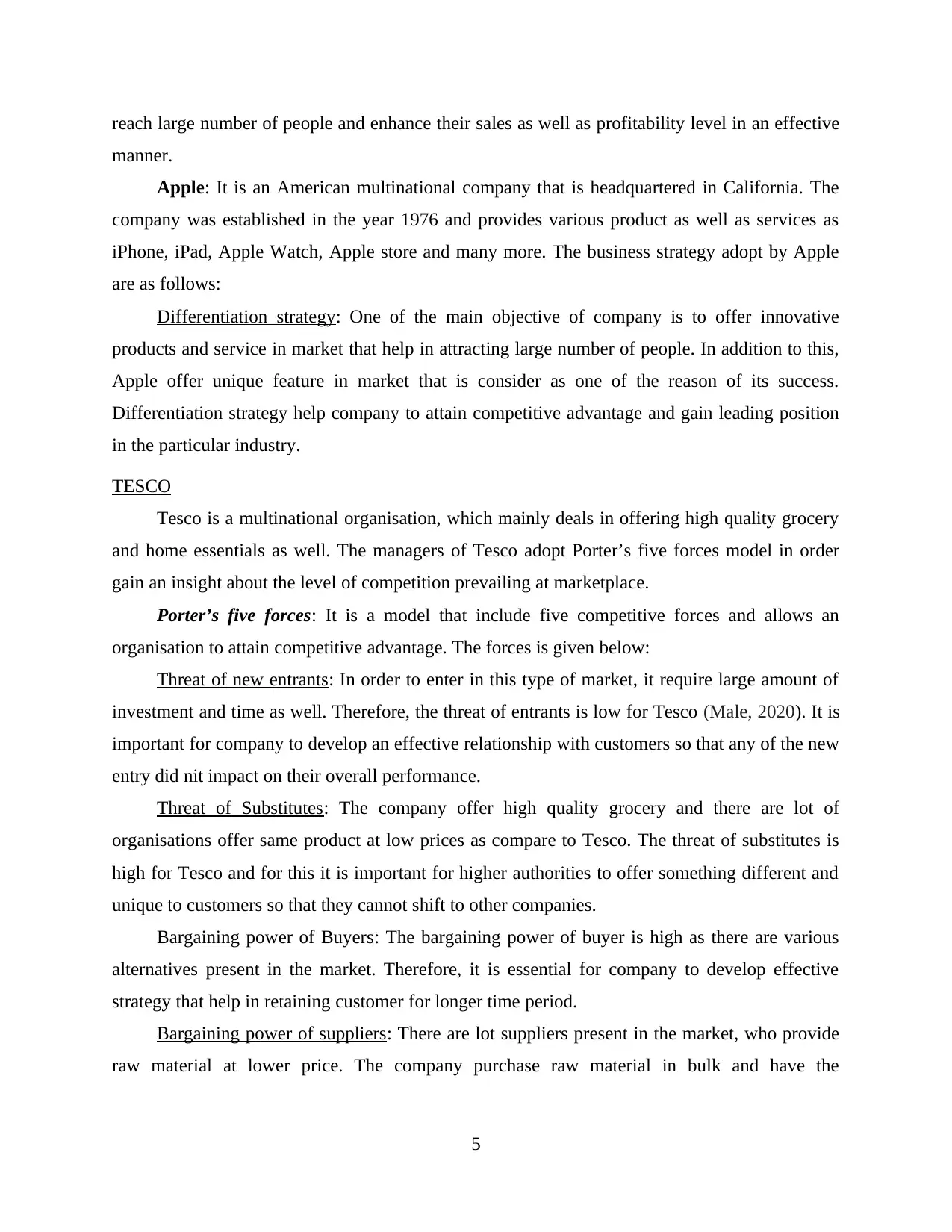
reach large number of people and enhance their sales as well as profitability level in an effective
manner.
Apple: It is an American multinational company that is headquartered in California. The
company was established in the year 1976 and provides various product as well as services as
iPhone, iPad, Apple Watch, Apple store and many more. The business strategy adopt by Apple
are as follows:
Differentiation strategy: One of the main objective of company is to offer innovative
products and service in market that help in attracting large number of people. In addition to this,
Apple offer unique feature in market that is consider as one of the reason of its success.
Differentiation strategy help company to attain competitive advantage and gain leading position
in the particular industry.
TESCO
Tesco is a multinational organisation, which mainly deals in offering high quality grocery
and home essentials as well. The managers of Tesco adopt Porter’s five forces model in order
gain an insight about the level of competition prevailing at marketplace.
Porter’s five forces: It is a model that include five competitive forces and allows an
organisation to attain competitive advantage. The forces is given below:
Threat of new entrants: In order to enter in this type of market, it require large amount of
investment and time as well. Therefore, the threat of entrants is low for Tesco (Male, 2020). It is
important for company to develop an effective relationship with customers so that any of the new
entry did nit impact on their overall performance.
Threat of Substitutes: The company offer high quality grocery and there are lot of
organisations offer same product at low prices as compare to Tesco. The threat of substitutes is
high for Tesco and for this it is important for higher authorities to offer something different and
unique to customers so that they cannot shift to other companies.
Bargaining power of Buyers: The bargaining power of buyer is high as there are various
alternatives present in the market. Therefore, it is essential for company to develop effective
strategy that help in retaining customer for longer time period.
Bargaining power of suppliers: There are lot suppliers present in the market, who provide
raw material at lower price. The company purchase raw material in bulk and have the
5
manner.
Apple: It is an American multinational company that is headquartered in California. The
company was established in the year 1976 and provides various product as well as services as
iPhone, iPad, Apple Watch, Apple store and many more. The business strategy adopt by Apple
are as follows:
Differentiation strategy: One of the main objective of company is to offer innovative
products and service in market that help in attracting large number of people. In addition to this,
Apple offer unique feature in market that is consider as one of the reason of its success.
Differentiation strategy help company to attain competitive advantage and gain leading position
in the particular industry.
TESCO
Tesco is a multinational organisation, which mainly deals in offering high quality grocery
and home essentials as well. The managers of Tesco adopt Porter’s five forces model in order
gain an insight about the level of competition prevailing at marketplace.
Porter’s five forces: It is a model that include five competitive forces and allows an
organisation to attain competitive advantage. The forces is given below:
Threat of new entrants: In order to enter in this type of market, it require large amount of
investment and time as well. Therefore, the threat of entrants is low for Tesco (Male, 2020). It is
important for company to develop an effective relationship with customers so that any of the new
entry did nit impact on their overall performance.
Threat of Substitutes: The company offer high quality grocery and there are lot of
organisations offer same product at low prices as compare to Tesco. The threat of substitutes is
high for Tesco and for this it is important for higher authorities to offer something different and
unique to customers so that they cannot shift to other companies.
Bargaining power of Buyers: The bargaining power of buyer is high as there are various
alternatives present in the market. Therefore, it is essential for company to develop effective
strategy that help in retaining customer for longer time period.
Bargaining power of suppliers: There are lot suppliers present in the market, who provide
raw material at lower price. The company purchase raw material in bulk and have the
5
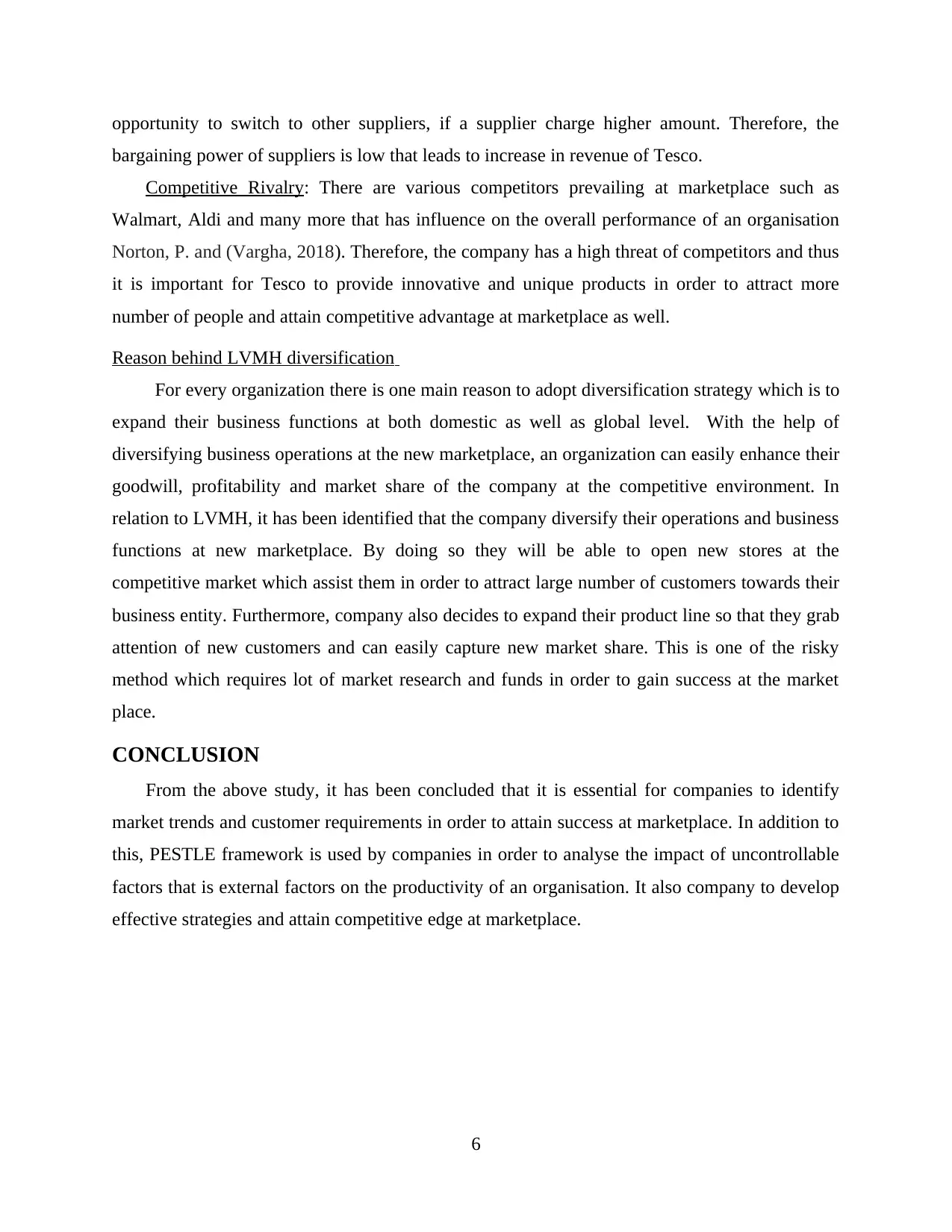
opportunity to switch to other suppliers, if a supplier charge higher amount. Therefore, the
bargaining power of suppliers is low that leads to increase in revenue of Tesco.
Competitive Rivalry: There are various competitors prevailing at marketplace such as
Walmart, Aldi and many more that has influence on the overall performance of an organisation
Norton, P. and (Vargha, 2018). Therefore, the company has a high threat of competitors and thus
it is important for Tesco to provide innovative and unique products in order to attract more
number of people and attain competitive advantage at marketplace as well.
Reason behind LVMH diversification
For every organization there is one main reason to adopt diversification strategy which is to
expand their business functions at both domestic as well as global level. With the help of
diversifying business operations at the new marketplace, an organization can easily enhance their
goodwill, profitability and market share of the company at the competitive environment. In
relation to LVMH, it has been identified that the company diversify their operations and business
functions at new marketplace. By doing so they will be able to open new stores at the
competitive market which assist them in order to attract large number of customers towards their
business entity. Furthermore, company also decides to expand their product line so that they grab
attention of new customers and can easily capture new market share. This is one of the risky
method which requires lot of market research and funds in order to gain success at the market
place.
CONCLUSION
From the above study, it has been concluded that it is essential for companies to identify
market trends and customer requirements in order to attain success at marketplace. In addition to
this, PESTLE framework is used by companies in order to analyse the impact of uncontrollable
factors that is external factors on the productivity of an organisation. It also company to develop
effective strategies and attain competitive edge at marketplace.
6
bargaining power of suppliers is low that leads to increase in revenue of Tesco.
Competitive Rivalry: There are various competitors prevailing at marketplace such as
Walmart, Aldi and many more that has influence on the overall performance of an organisation
Norton, P. and (Vargha, 2018). Therefore, the company has a high threat of competitors and thus
it is important for Tesco to provide innovative and unique products in order to attract more
number of people and attain competitive advantage at marketplace as well.
Reason behind LVMH diversification
For every organization there is one main reason to adopt diversification strategy which is to
expand their business functions at both domestic as well as global level. With the help of
diversifying business operations at the new marketplace, an organization can easily enhance their
goodwill, profitability and market share of the company at the competitive environment. In
relation to LVMH, it has been identified that the company diversify their operations and business
functions at new marketplace. By doing so they will be able to open new stores at the
competitive market which assist them in order to attract large number of customers towards their
business entity. Furthermore, company also decides to expand their product line so that they grab
attention of new customers and can easily capture new market share. This is one of the risky
method which requires lot of market research and funds in order to gain success at the market
place.
CONCLUSION
From the above study, it has been concluded that it is essential for companies to identify
market trends and customer requirements in order to attain success at marketplace. In addition to
this, PESTLE framework is used by companies in order to analyse the impact of uncontrollable
factors that is external factors on the productivity of an organisation. It also company to develop
effective strategies and attain competitive edge at marketplace.
6
⊘ This is a preview!⊘
Do you want full access?
Subscribe today to unlock all pages.

Trusted by 1+ million students worldwide
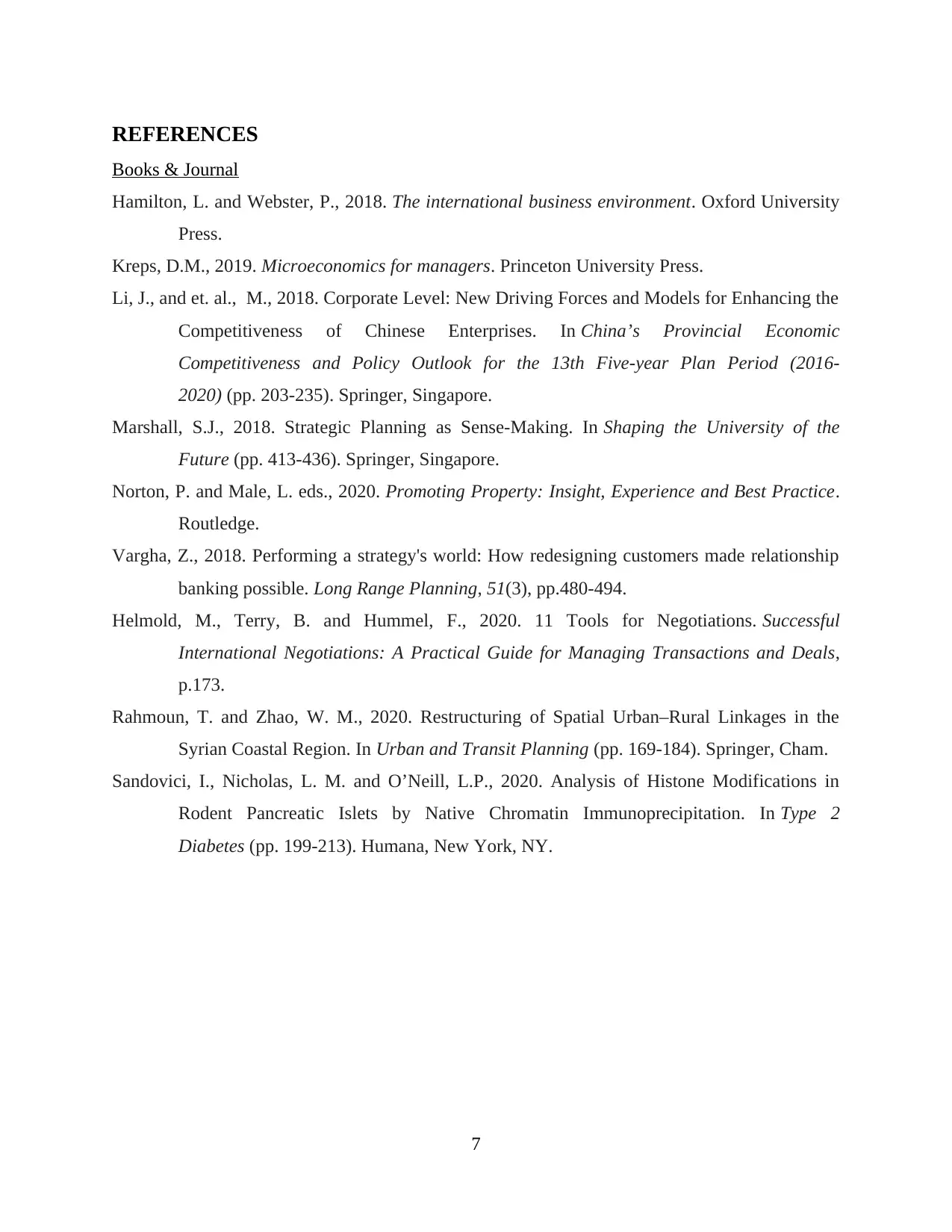
REFERENCES
Books & Journal
Hamilton, L. and Webster, P., 2018. The international business environment. Oxford University
Press.
Kreps, D.M., 2019. Microeconomics for managers. Princeton University Press.
Li, J., and et. al., M., 2018. Corporate Level: New Driving Forces and Models for Enhancing the
Competitiveness of Chinese Enterprises. In China’s Provincial Economic
Competitiveness and Policy Outlook for the 13th Five-year Plan Period (2016-
2020) (pp. 203-235). Springer, Singapore.
Marshall, S.J., 2018. Strategic Planning as Sense-Making. In Shaping the University of the
Future (pp. 413-436). Springer, Singapore.
Norton, P. and Male, L. eds., 2020. Promoting Property: Insight, Experience and Best Practice.
Routledge.
Vargha, Z., 2018. Performing a strategy's world: How redesigning customers made relationship
banking possible. Long Range Planning, 51(3), pp.480-494.
Helmold, M., Terry, B. and Hummel, F., 2020. 11 Tools for Negotiations. Successful
International Negotiations: A Practical Guide for Managing Transactions and Deals,
p.173.
Rahmoun, T. and Zhao, W. M., 2020. Restructuring of Spatial Urban–Rural Linkages in the
Syrian Coastal Region. In Urban and Transit Planning (pp. 169-184). Springer, Cham.
Sandovici, I., Nicholas, L. M. and O’Neill, L.P., 2020. Analysis of Histone Modifications in
Rodent Pancreatic Islets by Native Chromatin Immunoprecipitation. In Type 2
Diabetes (pp. 199-213). Humana, New York, NY.
7
Books & Journal
Hamilton, L. and Webster, P., 2018. The international business environment. Oxford University
Press.
Kreps, D.M., 2019. Microeconomics for managers. Princeton University Press.
Li, J., and et. al., M., 2018. Corporate Level: New Driving Forces and Models for Enhancing the
Competitiveness of Chinese Enterprises. In China’s Provincial Economic
Competitiveness and Policy Outlook for the 13th Five-year Plan Period (2016-
2020) (pp. 203-235). Springer, Singapore.
Marshall, S.J., 2018. Strategic Planning as Sense-Making. In Shaping the University of the
Future (pp. 413-436). Springer, Singapore.
Norton, P. and Male, L. eds., 2020. Promoting Property: Insight, Experience and Best Practice.
Routledge.
Vargha, Z., 2018. Performing a strategy's world: How redesigning customers made relationship
banking possible. Long Range Planning, 51(3), pp.480-494.
Helmold, M., Terry, B. and Hummel, F., 2020. 11 Tools for Negotiations. Successful
International Negotiations: A Practical Guide for Managing Transactions and Deals,
p.173.
Rahmoun, T. and Zhao, W. M., 2020. Restructuring of Spatial Urban–Rural Linkages in the
Syrian Coastal Region. In Urban and Transit Planning (pp. 169-184). Springer, Cham.
Sandovici, I., Nicholas, L. M. and O’Neill, L.P., 2020. Analysis of Histone Modifications in
Rodent Pancreatic Islets by Native Chromatin Immunoprecipitation. In Type 2
Diabetes (pp. 199-213). Humana, New York, NY.
7
Paraphrase This Document
Need a fresh take? Get an instant paraphrase of this document with our AI Paraphraser

8
1 out of 8
Related Documents
Your All-in-One AI-Powered Toolkit for Academic Success.
+13062052269
info@desklib.com
Available 24*7 on WhatsApp / Email
![[object Object]](/_next/static/media/star-bottom.7253800d.svg)
Unlock your academic potential
Copyright © 2020–2025 A2Z Services. All Rights Reserved. Developed and managed by ZUCOL.





